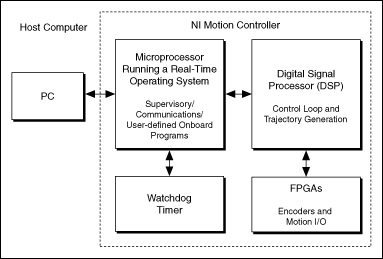NI 73xx Controller Architecture
NI 73xx controllers use a dual-processor architecture. The two processors, a central processing unit (CPU) and a digital signal processor (DSP), form the backbone of the NI motion controller.
The controller CPU is a 32-bit micro-controller running an embedded real time, multitasking operating system. This CPU offers the performance and determinism needed to solve most complex motion applications. The CPU performs command execution, host synchronization, I/O reaction, and system supervision.
The DSP has the primary responsibility of fast closed-loop control with simultaneous position, velocity, and trajectory maintenance on multiple axes. The DSP also closes the position and velocity loops, and directly commands the torque to the drive or amplifier.
Motion I/O occurs in hardware on an FPGA and consists of limit/home switch detection, position breakpoint, and high-speed capture. This ensures very low latencies in the range of hundreds of nanoseconds for breakpoints and high-speed captures. Refer to the Synchronization section for information about breakpoints and high-speed capture.
The motion controller processor is monitored by a watchdog timer, which is hardware that can be used to automatically detect software anomalies and reset the processor if any occur. The watchdog timer checks for proper processor operation. If the firmware on the motion controller is unable to process functions within 62 ms, the watchdog timer resets the motion controller and disallows further communications until you explicitly reset the motion controller. This ensures the real-time operation of the motion control system. The following functions may take longer than 62 ms to process:
- Save Defaults
- Reset Defaults
- Enable Auto Start
- Object Memory Management
- Clear Buffer
- End Storage
These functions are marked as non-real-time functions. Refer to the NI-Motion Function Help or the NI-Motion VI Help for more information.
The following block diagram illustrates the physical architecture of the NI motion controller hardware.

 |
Tip Because the NI SoftMotion Controller is not a hardware device, information about its architecture is not covered in this topic. Refer to NI SoftMotion Controller Architecture for information about the functional architecture specific to the NI SoftMotion Controller. |